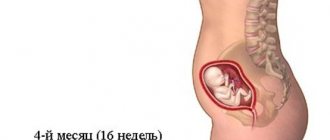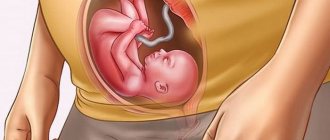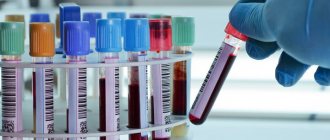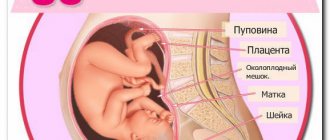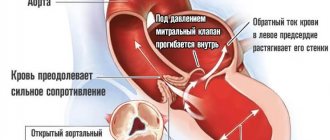At the present stage of development of medicine, ultrasound examination is an integral part of diagnosing the female body during gestation. Despite the fact that the non-invasive procedure has virtually no contraindications, during a routine examination during 9 months of bearing a child, it should be performed only 3 times. In this case, the most important is the first ultrasound screening, carried out at 10–12 weeks of pregnancy. But what makes it special?
Why is research done at this time?
During an ultrasound at 10 weeks of pregnancy, the doctor diagnoses:
- The very fact of pregnancy. False is determined when a fibroid or cyst could previously be mistaken for a fertilized egg.
- Location of pregnancy (uterine and ectopic). Signs of an ectopic pregnancy include bleeding and abdominal pain. An ectopic pregnancy must be removed.
- The viability of the embryo is determined by its heartbeat. If there is no heartbeat, a diagnosis of frozen pregnancy is made. Definitely deleted.
- The standard parameters of the embryo are measured: height, weight.
- The CTE of the embryo is determined - the ratio of the coccygeal-parietal size to the mass of the entire fetus. CTE is important at 10 weeks of development. Based on its deviations from the norm, serious pathologies can be identified. So, if the indicator is significantly lower than normal, this is a signal of a hormonal imbalance, an infection inside the mother’s body, or disorders inside the uterine cavity.
- The amount and color of amniotic fluid. If the amount of amniotic fluid in the uterus is excessive, this may be an indicator of poor kidney function of the mother or child. Chromosome abnormalities may also be a cause of slow development.
- If the fetus does not develop a nasal bone or noticeable thickening of the cervical spine, these are signals of genetic abnormalities.
Important! At the tenth week, serious malformations of the baby, pathologies of the uterus, and placenta can be determined. It is very important to identify deviations in time and take action.
Possible problems
The fears that pregnant women have are not always justified, so it is better to go through the procedure and find out for sure whether measures need to be taken. The following problems may occur.
The fertilized egg is not the right size for its term
A fairly common and worrying problem for pregnant women is the discrepancy between the size of the fertilized egg and accepted standards. But an ultrasound examination will show what size the SVD is. It really is below the norm. It is too early to talk about any violations. Most likely, in this case, the doctor will send the expectant mother for a repeat examination in a few weeks.
The reasons for not meeting the due date can be quite harmless: late ovulation or consolidation. All this affects the fact that the fetus develops later than stated. But pathological causes, as a rule, include developmental delays. This factor is largely influenced by the mother’s health status, lifestyle (diet, bad habits, etc.), past illnesses and medications taken in the early stages.
Another group of factors are genetic diseases, developmental defects and the like. But they cannot yet be determined. It will be possible to speak more precisely about this only in a few weeks, when the first screening is scheduled. It is important to carefully monitor the situation and monitor possible accompanying symptoms - tone, lack of heartbeat, and so on.
KTR does not meet deadline
If the doctor does not find any other problems other than a decrease in CTE, then this is simply a reason to reconsider the indicated pregnancy dates. Most likely, they were calculated incorrectly. The results need to be rechecked. And an ultrasound examination will show a more accurate picture at 12 weeks. In this case, it is important to take into account that chromosomal abnormalities (the risk of developing Down syndrome and others) can affect the slowdown in development.
Another thing is a discrepancy between the CTE in combination with other signs. For example, with the absence of signs of life in the fetus. In this case, the woman must be hospitalized. Such conditions require surgical curettage.
Normally, CTE can be reduced if there is a multiple pregnancy. This option is not pathological.
Mother's condition and how pregnancy develops
By this time, the woman is probably already accustomed to the fact that a baby is developing inside her.
Her breasts swell every week, and her body weight begins to increase. The heart pumps more blood. Therefore, it is useful to walk to improve blood circulation in the body.
Do not cross your legs when sitting - this can lead to varicose veins.
By this time the fetus on ultrasound is already the size of an apricot. His vision develops, the beginnings of teeth appear, and hair begins to grow. The nervous system is already divided into central and peripheral, and the brain is actively developing. The placenta forms and the umbilical cord grows. The immune system begins to emerge.
Mother. Changes in the body's condition at 10 weeks
Condition of the mother at the 10th week of pregnancy
At the 10th obstetric week of pregnancy, the mother notes a continued increase in waist circumference. It’s becoming more and more difficult to wear your old clothes and it’s time to think about updating your wardrobe.
It is ideal if a woman chooses clothes specifically designed for pregnant women.
Pants, dresses, skirts and sweaters created for pregnant women differ from ordinary clothing in their cut and materials used. Typically, stretch fabric is used around the chest and abdomen to provide support and relieve pressure.
External changes put a pregnant woman in a positive mood, but manifestations of toxicosis can continue to bother her.
Most expectant mothers note a decrease in the intensity of the manifestations of toxicosis, but in some cases deterioration may be observed.
Most often, in the 10th week of pregnancy (according to obstetric calculations), women complain of:
- nausea and vomiting. These manifestations can occur in the morning or throughout the day. If vomiting occurs no more than 3 times a day, there is nothing to worry about, but you should warn your gynecologist about it;
- increased blood pressure, headaches, exacerbation of hemorrhoids. If a woman had health problems before pregnancy, then in the 10th week of pregnancy she may experience a worsening of her condition. You must tell your doctor about all unpleasant manifestations to receive timely consultation and prescriptions;
- constant fatigue, drowsiness, absent-mindedness. During the first trimester (the first 12 weeks of pregnancy), a woman’s body is rebuilt and works at full capacity. What was not difficult before pregnancy can be an overwhelming task in these 3 months. You should carefully monitor the regularity of the load, get good sleep, eat right;
- unstable mental state. From laughter to tears and back again in the 10th week is a normal state. The body has not yet fully adapted to the increased hormonal levels. It is possible to overcome these manifestations only if you pull yourself together, learn to restrain negative emotions, and switch;
- the appearance of age spots on the face and body. These unpleasant pregnancy companions cause a lot of anxiety among pregnant women who are afraid that they will remain forever. It's a delusion. After giving birth, within a year, the woman’s hormonal levels gradually return to normal and pigmentation goes away on its own;
- pain in legs, back. Some women experience swelling in their legs at the 10th week of pregnancy and a load on the spine is felt, resulting in mild pain. If these symptoms appear, you must consult a gynecologist for diagnosis of the condition and timely treatment. In this way, incipient varicose veins, an incorrect diet that affects the woman’s health, and other undesirable manifestations can manifest themselves.
What does an ultrasound show and what do they look for?
At this point, the ultrasound clearly shows the completed process of formation of the main organs of the embryo. Then only their growth occurs. All possible pathologies have already formed, and their absence indicates a successful pregnancy.
The 2 most important parameters of the embryo are determined:
- KTR;
- diameter of the fertilized egg.
Important! If the diameter of the egg is normal, but the embryo itself is not visible, then this may be a fact of a frozen pregnancy.
Normally, the fetus is 30-40 cm tall and weighs up to 5 g. The spinal column is clearly visible on ultrasound. You can see the arms and legs that the baby is already actively moving.
Next, the vital activity of the embryo is determined by:
- heartbeat;
- movement activity.
The doctor must listen to the heart and determine the number of contractions per minute. Normally there should be 150-160 beats. If there is a deviation from the norm, measures must be taken to determine the cause of the defects and make decisions based on the situation.
During an ultrasound at 10 weeks, you can see the fetus moving. By this time he had learned to roll over, push off the walls of the uterus, and move his arms. The kidneys, liver, intestines and pancreas also activate their work.
The doctor must check the presence of each organ and evaluate its performance. During the examination, doctors can see defects of the heart, face and other organs.
Also, the doctor may use an ultrasound to detect abnormalities in the uterus itself, thickening of its walls, and hypertonicity. In these cases, therapeutic treatment is prescribed aimed at maintaining pregnancy.
An important result of an ultrasound at 10 weeks is that at this stage it is still possible to make a decision, in case of serious deviations, about the advisability of continuing the development of the fetus.
What severe disorders in fetal development can be identified?
So, week 10 is a fairly short period of time for the first ultrasound screening. But, despite this, professional sonologists can already determine at an early stage the presence of serious illnesses, which not only complicate the child’s quality of life in the future, but also cause premature death. There is a special category of diseases associated with a malfunction in the human chromosomal program. In most cases, these diseases cannot be corrected.
These include the following syndromes:
How many times can an ultrasound be done throughout pregnancy?
- Patau - pathology is characterized by high mortality in early childhood (only 2-3% of newborns survive to 9-10 years). A child with this disease may have multiple spleens, low weight, extreme mental retardation, cyclopia, a wide nose, an enlarged liver and a disproportionately short neck.
- Turner's disease is characterized by damage to almost all body systems. The most common physiological consequences of its manifestation include short stature, lymph congestion, high blood pressure, excess skin, idiocy, etc. If the most severe signs bypass the baby, then the likelihood of a full life expectancy increases.
- Edwards is also one of the fatal diseases. According to medical statistics, patients are most often diagnosed with underdevelopment of the lower jaw and palate, complete absence of kidneys, congenital heart disease, deformation of the ears and limbs, cerebellar hypoplasia and widened chest.
- Down is a less dangerous pathology, compared to a number of chromosomal mutations, which allows people to live more than 50 years with appropriate care. Indicative signs of the syndrome are shortened limbs, strabismus, muscle hypotonia, brachycephaly, underdeveloped neck and cataracts.
- Cornelia de Lange is a disease characterized by symptoms such as voluntary seizures, fused eyebrows, microcephaly, mental retardation, shortened limbs, myopia and astigmatism. If parents pay due attention to the health and development of their special baby, then the little person will have a chance for timely socialization and improvement of vital skills.
In some cases, a specialist identifies large cysts or uterine fibroids during an ultrasound, which can also masquerade as a fertilized egg. This disease is called false pregnancy, which requires immediate medical intervention.
How do they do it?
An ultrasound scan during pregnancy is a mandatory and extremely important procedure.
It can be done in 2 ways:
- Transvaginally (the sensor is inserted into the vagina).
- Transabdominal (the sensor is moved along the surface of the abdomen).
The transvaginal method is used only in the initial stages of pregnancy. Starting from 7-8 weeks, ultrasound is recommended to be done in the second way, so as not to harm the pregnancy.
In both cases, the ultrasound results are displayed on the monitor, where the doctor conducts research and analyzes the data seen. During the transabdominal examination, the woman lies down on the couch. A special gel is applied to the stomach. And along it there is a sensor that emits an ultrasonic signal and transmits the result to the monitor.
The expectant mother and her changes
The next visit to the ultrasound diagnostician will allow you to hear the fetal heartbeat. Before conception, the size of the uterus was no larger than a pear; now its size has increased to the size of a grapefruit. You may notice that your regular clothes, including your bra, are getting small - it's time to find more comfortable clothes. At this time, you can begin physical activity to keep fit: swimming, Pilates, yoga. Please note that the loads should be moderate and not cause discomfort during or after exercise.
By the 10th week, toxicosis and malaise in the morning gradually ends.
How to prepare?
For ultrasound, which is performed on the surface of the abdomen, there are rules, and their implementation is mandatory:
- You need to drink about half a liter of water and come to the ultrasound with a full bladder.
- You should not eat or drink foods that cause intestinal bloating.
No additional preparation is required for transvaginal ultrasound. The bladder should be empty. A condom lubricated with a special gel is placed on the sensor. An ultrasound examination is performed.
Recommendations
During the 10th week of pregnancy, your baby's baby teeth begin to form. This means that in the diet you need to focus on foods containing calcium (legumes, almonds, sesame and poppy seeds, wholemeal bread, leaf and watercress, rose hips, broccoli, asparagus, carrots, radishes, sardines, salmon, milk and dairy products). Enrich your diet with them, because your teeth can also suffer from a lack of calcium. The body also needs iodine - now it begins to accumulate in the baby’s thyroid gland.
Continue to monitor your health as you enter the 10th week of pregnancy.
- Take care of proper nutrition. Reduce the amount of fatty and fried foods and smoked foods in your diet. It is better if you stew, bake or steam dishes. Limit your salt and sugar intake;
- Be physically active. Overload should not be allowed, but as long as the tummy does not interfere, you can do swimming, yoga, gymnastics for pregnant women, and take daily walks in the fresh air. This will improve metabolism and enrich the blood with oxygen;
- To prevent dehydration, consume enough fluids during the 10th week of pregnancy. Drink water, freshly squeezed juices, do not neglect first courses, eat more seasonal berries and fruits, which contain a lot of vitamins and water (watermelons, melons, pears, oranges, grapes, etc.). Additional fluid will help maintain skin elasticity, increase blood volume, maintain normal amniotic fluid volume, reduce the risk of genital infections and relieve constipation;
- Learn to relax, recharge yourself with positive emotions: meet with friends, think about your hobby or discover some new interesting hobby.
Who is recommended for ultrasound diagnostics at 10 weeks?
Usually an ultrasound is prescribed at the 12th week of pregnancy, this is the planned period.
But sometimes it is important to do it exactly at week 10:
- If bleeding starts. Mandatory to detect an ectopic, frozen or false pregnancy.
- During IVF. During in vitro fertilization, 2 embryos are implanted into the uterus, and one subsequently becomes the placenta for the second. But sometimes a marriage happens, leaving 2 fruits. To monitor the situation, an ultrasound is performed at 10 weeks.
- If there is a high risk of genetic transmission of congenital defects to the embryo, so that in a difficult situation it is not too late to make a decision about the further development of the fetus.
- During suspected multiple pregnancy.
- If there is a threat of miscarriage, when there is increased uterine tone, uncharacteristic discharge, abdominal pain or previous cases of spontaneous abortion.
In any of these cases, it is very important to conduct an ultrasound in time, identify pathology, or ensure the successful development of the unborn baby.
Important! It is necessary to monitor your well-being, and at the first signal, inform the gynecologist about your problem.
It is possible and it is not possible
Do's and don'ts during the 10th week of pregnancy
At the 10th week of pregnancy (according to obstetric calculations), it is necessary to follow a number of rules to reduce the manifestations of toxicosis, organize suitable conditions for the development of the fetus, and maintain the health of the expectant mother.
Among the mandatory conditions that every pregnant woman must fulfill, special attention is required:
- absence of harmful substances in a woman’s life: smoking (active and passive);
- alcohol;
- narcotic substances;
- fast food;
- smoked and pickled foods;
- soda;
- contact with chemical compounds (detergents, building materials, hair dye and cosmetics based on complex chemical compounds).
In addition to these basic rules, a pregnant woman should follow the following recommendations:
- Avoid prolonged exposure to direct sunlight in the summer. Be sure to use sun cream;
- purchase and constantly wear clothes designed for pregnant women. This is especially true for bras;
- do not wear high-heeled shoes, give preference to ballet flats or slippers;
- while sitting, do not cross your legs or cross your legs. It’s great if the woman puts them straight and even throughout her pregnancy;
- do not take a hot bath, do not steam your feet, and in the first trimester avoid visiting baths and saunas.
The rules for a pregnant woman are very easy to follow if you take them seriously. They contain the basic principles of a healthy lifestyle. Once you get used to them during pregnancy, it is easy to continue doing them later.
It will be simply wonderful if a mother, by her own example, begins to teach her child to maintain and improve health from an early age.
Sex
Sex in the 10th week of pregnancy is not prohibited, unless there are symptoms indicating a threat of miscarriage. The only “but” is a decrease in libido in a woman during the current period. This is normal.
The processes occurring in the body of the expectant mother reduce the production of certain hormones responsible for arousal, as a result of which the woman does not feel the need for intimate life.
Sexual contact in the 10th week of pregnancy should be a mutual desire, not an obligation.
What can be seen in the photo of the fetus?
Many expectant mothers ask to save the image from the monitor during the examination and store the ultrasound photo at the 10th week of pregnancy for many years.
Looking closely at the photo, you can see an embryo with clearly visible arms and legs. Some even see the child sucking his finger or yawning. Fingers are visible on the hands and feet. The location of the ears is visible on the head.
If an ultrasound is performed on a good high-resolution monitor, then you can see the heart, stomach, kidneys and liver in the photo. Sometimes you can see a small fluff on the skin.
Mom's feelings
Pregnancy of 9–10 weeks is characterized by activation of the metabolic processes of the expectant mother. Gradually, the mother’s blood volume decreases, so the body has an increased load, despite the fact that your baby is still so small. There is an expansion of blood vessels in the pelvic basin - this is how your body adapts so that the baby receives everything it needs. Because of this, the mother's other organs may not receive enough oxygen, and from time to time you may experience dizziness and weakness. This is especially true for women who have had low hemoglobin during pregnancy. For the same reason, you may notice how sometimes it is difficult to do normal work, and sometimes even when reading a book it is difficult to concentrate.
Due to changes in hormonal balance, you may also notice frequent mood swings, tearfulness, and increased irritability. Try not to blame everything on hormones, this will make it easier to adapt to the new state. Moreover, very soon hormonal balance will be established, and your well-being, as well as your mood, will improve significantly.
Many mothers may still have signs of toxicosis at 10 weeks of pregnancy: nausea, aversion to certain foods, weakness, fatigue. Try to spend more time relaxing, take care of yourself, go for a walk, if possible, work less during this period.
Frequent urination is an integral part of pregnancy. For now, this may not bother you too much, but you need to monitor your feelings: if there are cramps or pain when urinating, you need to go to the doctor, as this is a sign of an inflammatory process. Infections of the genitourinary organs often accompany pregnancy, because the expectant mother has a reduced immune system - this is a natural reaction of the body that allows you to bear a baby. Any suspicion of inflammation is a reason to consult a doctor, because the disease can harm the baby, and self-medication during pregnancy is strictly unacceptable.
Decreased immunity in pregnant women also leads to the frequent development of thrush. Therefore, you need to monitor the nature of the discharge. They should not change significantly, but may become somewhat more abundant. The development of fungal inflammation is facilitated by the preparation of the vaginal mucosa, which occurs under the influence of progesterone. The mucous membrane has become more loose. If vaginal candidiasis develops, the doctor will prescribe local treatment that is safe for the baby. It must also be remembered that abundant carbohydrate nutrition contributes to changes in vaginal pH, which is favorable for the development of fungal flora.
At the end of the first trimester, mom may have difficulty sleeping. The reason for this is both anxiety and hormonal changes. Your thoughts are often occupied with how the pregnancy will proceed, how you will meet the baby, and whether everything will be okay. Therefore, psychological comfort is very important now. Try to take a walk with your spouse before going to bed and listen to pleasant music. The belly at the 10th week of pregnancy is not yet so enlarged as to prevent the mother from taking a comfortable position while sleeping, but if you are used to sleeping on your stomach, you need to give it up. Train yourself to sleep on your side, this is the optimal position for late pregnancy, when you can’t even sleep on your back - the uterus compresses the blood vessels.
10 weeks pregnant with twins
Carrying twins is a double happiness, but also a double burden on the mother’s body. You may feel that you get tired too quickly and have no strength to do your usual work. Try to rest more, entrust household chores to your relatives. Walk in the fresh air, pay attention to your diet. In general, in the early stages, pregnancy with twins proceeds the same way: your babies are actively growing, developing quickly, and soon you will fully feel that there are two of them.
Indicators of ultrasound examination norms
In order to determine the healthy course of pregnancy, doctors compare all indicators with developed standards. Based on the deviations, appropriate conclusions are drawn.
Parameters, their standards:
- embryo length 28-42 mm;
- weight 5-8 g;
- KTR 33-50 mm;
- heart rate 150-190 beats per minute;
- biparental head size 14 mm;
- the location of the fetus inside the uterus is any;
- presence of a nasal bone;
- thickness of the cervical region in the collar area 0.8-2.2 mm;
- uterine tone;
- the presence of a placenta does not have to be at this stage;
- presence and color of water around the fetus. They should be up to 20 ml and the color should not be cloudy;
- both uterine os are closed, the cervix is not shorter than 3 cm;
- The chorion should not block the uterine os.
Reference! If there is a slight deviation from these norms, the doctor may prescribe a repeat ultrasound after 2 weeks and additional tests.
In cases where serious deviations are detected, additional special tests are prescribed, and when the result is confirmed, a decision is made to interrupt.
Nutrition
Some mothers find it difficult to choose the optimal menu for themselves at this stage of pregnancy. After all, there may still be an aversion to many foods. Try to diversify your diet - introduce completely new dishes from healthy products, you might like it. Usually, a pregnant woman’s body, even with toxicosis, responds well to natural products: vegetables, fruits, natural yogurt, dietary meat. Your baby's body is growing incredibly quickly right now, and it needs a lot of different nutrients.
From the very beginning of pregnancy, or even better before it, you should receive a complex of vitamins and microelements. If for some reason you have not done this yet, consult your doctor, he will help you choose a good drug. If toxicosis is very severe, eat what you like. Of course, with the exception of foods that are harmful to the baby: fried foods, preservatives, dyes, carbonated drinks, etc. Eat small portions, but often. Very soon the nausea will completely pass, and you will be able to enjoy healthy foods to the fullest.
Where do they make it and how much does it cost?
Ultrasound examinations in Russia are performed free of charge in clinics where a woman registers with a gynecologist and in maternity hospitals, where they can be referred if necessary. There are also many private clinics that have the right to conduct this research for a fee.
The average cost of one procedure ranges from 500 to 2000 rubles. This price range depends on the quality of the equipment used, the degree of qualification of the doctor, as well as the region and degree of prestige of the clinic.
Risk factors
At 10 weeks of pregnancy, there is a high risk of developing genital infections. Most often, expectant mothers are diagnosed with candidiasis (thrush), but infection with chlamydia, gonococci, trichomonas and other pathogenic microorganisms is possible. Regardless of the nature of the disease, it must be treated, otherwise intrauterine infection of the fetus may occur, and this can lead to disruption of its development or even death. Observe vaginal discharge. Normally, they should be transparent or light milky, of uniform consistency, with only a slight sour odor or no odor at all. If the discharge turns green-gray or yellow, if bubbles or flakes appear in it, if it resembles curdled mass and acquires a strong unpleasant odor, go to the doctor immediately.
You should also be wary of brown or bloody discharge at 10 weeks of pregnancy. A small amount of blood may appear after an examination by a gynecologist or after sexual intercourse. Most often this is explained by erosion of the cervix, the loose tissue of which is damaged by external intervention. But when the discharge is accompanied by cramping pain in the abdomen, this may be a sign of spontaneous abortion. Therefore, if you discover such symptoms, immediately seek qualified help: a timely response is a chance to save the child.
